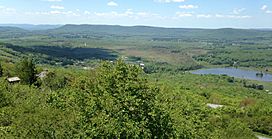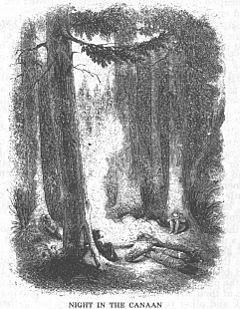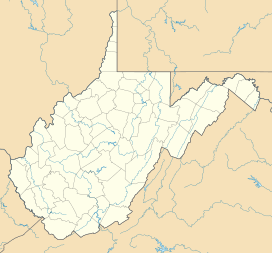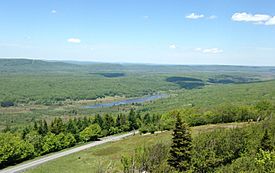Canaan Valley facts for kids
Quick facts for kids Canaan Valley |
|
|---|---|

View of the southern end of Canaan Valley from atop Harmon Knob.
|
|
| Floor elevation | 3,200 ft (980 m) |
| Area | 39 sq mi (100 km2) |
| Geography | |
| Country | United States |
| State | West Virginia |
| County | Tucker |
Canaan Valley is a large, flat valley shaped like a bathtub in northeastern Tucker County, West Virginia, USA. It's famous for its huge wetlands and is where the Blackwater River begins. This river then flows out of the valley, creating the beautiful Blackwater Falls.
Canaan Valley is a popular place for tourists and nature lovers. Since 1994, almost 70% of the valley has become the Canaan Valley National Wildlife Refuge. This refuge was the 500th National Wildlife Refuge in the United States! Nearby, you can also find Canaan Valley Resort State Park and Blackwater Falls State Park.
In 1974, Canaan Valley was named a National Natural Landmark. This means it's a very special natural area. The National Park Service said it's like a "museum" of ancient habitats from the Pleistocene Ice Age. It's unique because it has a "boreal relict" community, which means it has plants and animals usually found much farther north, like in Canada.
The name "Canaan" is pronounced "kuh-NANE" by local people. This is different from how the Biblical region is usually pronounced. A legend says that a German settler named the valley because it reminded him of the beautiful land of Canaan from the Bible, but he mispronounced the name, and it stuck!
However, some people think the valley was originally called the "Canadian Valley." This is because it looks a lot like parts of Canada. Early explorers described it as a wild, difficult place, not like the "land of milk and honey" from the Bible. The river flowing out of it was even called the "River of Styx" (River of the Dead), which is now called the Blackwater River.
Contents
Exploring Canaan Valley's Geography
Canaan Valley is tucked away among the tall Allegheny Mountains. It's about 13 miles (21 km) long and 3 to 5 miles (5 to 8 km) wide. Canaan Mountain is to its west, and Cabin Mountain is to its east. The northern part of Cabin Mountain is even part of the Eastern Continental Divide, which separates rivers flowing to the Atlantic from those flowing elsewhere.
The valley floor is very flat and covers about 25,000 acres (100 km²). It's quite high up, averaging 3,200 feet (975 m) above sea level. This makes it the highest large valley east of the Mississippi River! The mountains around it rise even higher, up to 4,450 feet (1,356 m) at Weiss Knob.
The Blackwater River starts in the southern part of the valley. It flows from many bogs and beaver ponds. The famous Blackwater Falls are where the river leaves the valley, cutting through a gap between Brown and Canaan Mountains.
How Was Canaan Valley Formed?
Canaan Valley is a type of valley called a "muskeg" that sits on an anticline. An anticline is a fold in rock layers that looks like an arch. The valley was carved into the soft shale rock of the Blackwater Anticline.
About a million years ago, the Blackwater River started cutting into the older rock layers from the Mississippian and Pennsylvanian ages (345–270 million years ago). The harder sandstone layers above these softer rocks form the mountains around the valley and the edge of the Blackwater Gorge.
What's the Weather Like in Canaan Valley?
Because Canaan Valley is so high up (3,200 feet or 975 m), it has a cooler and wetter climate than nearby lower areas.
Summers in the Valley
Summers are cool and humid. Afternoon temperatures usually reach the mid-70s °F (around 24 °C). In the mornings, temperatures drop to the low to mid-50s °F (around 10-13 °C). The growing season for plants is very short, only about 95 days. This is even shorter than in Fairbanks, Alaska! It can even freeze in June, July, or August.
Winters in the Valley
Winters are very cold and snowy. On average, the valley gets about 170 inches (432 cm) of snow each winter. The most snow ever recorded was 257 inches (653 cm) in the winter of 1995–96! Even in mild winters, more than 5 feet (1.5 m) of snow falls. Snow usually piles up to 2 feet (0.6 m) deep by late February, and in very cold winters, it can be over 4 feet (1.2 m) deep in the woods.
The valley's location means it gets a lot of snow from "upslope snow" (also called Orographic lift). This happens when moist air from the Great Lakes blows over the mountains and drops snow. It can even cause blizzards! The valley is also sometimes affected by "Nor'easters," which are big storms from the Atlantic Ocean that bring heavy snow.
A Look Back at Canaan Valley's History

Early Times and First Settlers
About 15,000 years ago, glaciers moving south greatly affected Canaan Valley. Even though the glaciers didn't reach the valley, the climate became very cool and wet. As the ice melted, many cold-loving plants stayed behind. Later, a very thick red spruce forest grew, mixed with balsam fir and other trees.
The first Europeans to see Canaan Valley were probably surveyors in 1746. They had a very difficult time crossing Canaan Mountain.
The story of how Canaan Valley got its name is interesting. A legend says that in 1748, a German settler named Henry Fansler looked at the valley and said, "Behold the Land of Canaan!" He thought it was as beautiful as the Biblical land. However, earlier descriptions from the 1700s called the valley "gloomy" and "forbidding." The river was even called the "River of the Dead." This has led some people to believe the original name might have been "the Canadian Valley" because of its cold climate and Canadian-like forests.
Henry Fansler and his family tried to live in the valley for three years. But the harsh winters and poor farming made them move. He was the first known settler, though others may have tried before him.
The "High Allegheny" region, including Canaan Valley, was very wild and remote for a long time. In the 1800s, it was a last safe place for large animals like elk. In 1843, some of the last wild elk in what became West Virginia were hunted here.
The first settler to successfully live in the valley for a long time was Solomon W. Cosner, who arrived in 1864. He was a Civil War veteran and a famous bear hunter. He and his sons were said to have hunted over 500 bears in the valley! Other families started settling in the 1870s.
In 1883, a land investor named Charles R. Ruffin bought 5,000 acres (20 km²) of the valley. He wanted to create a huge cattle ranch, but his plan didn't work out.
Logging and Wildfires
Logging was a big industry in the mountains around the valley in the late 1800s. But the thick rhododendron plants on the valley floor made it hard to get through. This changed when a logging railroad was built in 1915.
Between 1888 and 1922, a lot of timber was taken from the valley. The amount of wood was huge! But this logging caused terrible damage. After all the trees were cut, the ground dried out, and huge fires started. One fire burned for months, even through rain and snow. It destroyed almost all the plant life. The town of Davis was saved only because deep trenches were dug around it and filled with water. After the fire, the valley was left with bare rocks and thin soil.
In 1923, the West Virginia Power and Transmission Company (WVPTC) bought 13,230 acres (53.5 km²) in the northern valley. They planned to build a hydroelectric power plant that would flood much of the valley. This company didn't intend to protect nature, but their purchase actually helped save the wetlands from being developed later on.
Recovery and Growth
In 1920, the southern part of the valley became part of the new Monongahela National Forest. This was an effort to regrow the forests that had been cut down. The logging railroads were removed in 1925.
In 1932, West Virginia Route 32 was built through the southern end of the valley. This was the only main road and led to more development. Electricity came to this area in 1938.
In the late 1930s, the Civilian Conservation Corps helped replant trees on Canaan Mountain. They even brought in soil by truck to areas where there was none. By the 1940s, a new spruce forest was growing. During World War II, the U.S. Army used Canaan Valley for training, practicing with artillery and mortars.
In the 1950s, ski slopes started to be developed on Cabin Mountain and Weiss Knob. Because of the valley's cool climate, snow often stays on these slopes until April or later. In the early 1970s, Canaan Valley Resort State Park was created to further develop skiing and tourism. An 18-hole golf course was also built there.
Amazing Nature: Plants and Animals
Wetlands and Northern Plants
Canaan Valley has many plants and animals found throughout West Virginia. But it also has 40 special plant communities with species usually found only in cold, northern places like sub-arctic bogs and conifer forests. That's why ecologists call it "a bit of Canada gone astray"!
The valley's most amazing feature is its huge wetlands. These are the largest in the entire central and southern Appalachian region. They are the second largest inland wetland area in the United States! These 8,400 acres (34 km²) of shrub swamp and bog make up about 40% of all the wetlands in West Virginia.
Plants of Canaan Valley
More than 580 types of plants have been found in the valley. Some notable ones include various mosses, sedges, and heathers. You can also find the large cranberry and the Canadian blueberry. Other interesting plants are the sundew (an insect-eating plant!), marsh marigold, jack-in-the-pulpit, starflower, and Canadian lily-of-the-valley. In late August, you can see impressive blooms of cotton grass, a plant mostly found in Alaska and Canada.
Animals of Canaan Valley
Over 280 animal species have been recorded in the valley.
Mammals The valley and surrounding highlands are home to some of the southernmost snowshoe hares. Other mammals include beavers, muskrats, raccoons, opossums, and grey and red squirrels. You might also spot black bears, bobcats, coyotes, and red foxes, though they are seen less often. Large groups of white-tailed deer are common and can often be seen from the roads. Please remember not to feed or interact with the deer.
Birds Birdwatching is popular here, especially for birds that love wetlands. These include ducks (wood ducks, mallards, black ducks), Canada geese, and the great blue heron. The wetlands are the southernmost nesting site for the American bittern. Many migratory songbirds also visit, like the golden-winged warbler, scarlet tanager, indigo bunting, and Canada warbler. You might also see raptors like red-tailed hawks, goshawks, and sometimes even a peregrine falcon or bald eagle.
Fish Smallmouth bass and other sunfish live in the upper Blackwater River. You can also find native brook trout and introduced rainbow trout in the cold, clean streams.
Fun Things to Do in Canaan Valley
Canaan Valley's unique climate and nature attract many people who love the outdoors. Here are some popular activities:
- Camping
- Hiking
- Fishing (for trout and bass)
- Cross-country and downhill skiing
- "Leaf-peeping" (enjoying the fall colors)
- Wildlife viewing
Upland game bird hunting (for birds like woodcock, ruffed grouse, common snipe, and wild turkey) is also allowed in season, even in the National Wildlife Refuge.
Besides the two state parks and the wildlife refuge, the valley has two Alpine ski resorts: Canaan Valley Ski Resort and Timberline Mountain. There's also a Nordic ski area called White Grass Ski Touring Center.
Images for kids
-
David Hunter Strother's 1853 engraving "Night in the Canaan". No trace of the great primeval red spruce forest remains today.








